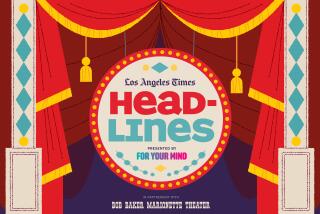‘My Extreme Animal Phobia’ explores fears of creatures big and small
- Share via
Medical reality television has a new kid on the block: “My Extreme Animal Phobia,” in which people face their terror of four-footed and creepy-crawly creatures. Why extreme? Because when it comes to mental and physical health disorders on TV, the bigger the better.
The show, which debuts Oct. 21, features three people temporarily living in a clinic trying to overcome (with the help of a therapist) their acute fears about various animals. The premiere episode features people who are deathly afraid of spiders, pit bulls and snakes. Many of us freak out at the sight of a moth or a rat, or know someone who does; a true full-blown phobia is an intense, irrational fear that can cause intense stress and interfere with day-to-day life, such as staying out of parks to avoid dogs.
On “My Extreme Animal Phobia”, host Robin Zasio, a Sacramento-based licensed clinical psychologist, uses exposure therapy to help people overcome their fears, and through counseling she tries to get to the root of the phobia. On the debut episode, a macho guy named Marvin with a facial tattoo trembles and sobs at the sight of a pit bull puppy. A young woman named Jahara hermetically seals herself and her children inside their home to make sure spiders don’t get in. Trips to the park are short-lived if she sees an eight-legged critter.
Since our fondness for medical reality shows has been well documented, we couldn’t help but write about this new show. We spoke to Zasio by phone; some of you know her as one of the featured therapists on the A&E show “Hoarders.”
“When people are afraid of everyday animals, like dogs or cats or spiders, they’re embarrassed about it,” she said. They know, for example, that people keep dogs as pets -- they just happen to be terrified of them.
Zasio uses exposure therapy for her patients, the established form of treatment for phobias. Usually patients are gradually exposed to the object of their fear via photos or videos, eventually working up to touching the animal so they become desensitized and realize they won’t be harmed.
Zasio said the five-day-long therapy is “a kind of boot camp exposure,” and added, “but I never ask someone to do something I wouldn’t do, and I never trick or force someone to do something.”
Animal phobias are fairly treatable, and treatment typically doesn’t take a long time, says Martin Antony, professor of psychology at Ryerson University in Toronto and co-author of “Overcoming Animal and Insect Phobias: How to Conquer Fear of Dogs, Snakes, Rodents, Bees, Spiders, and More” (Antony has appeared on Animal Planet a couple of times but is not affiliated with the show). The problem is, not everyone who has a phobia seeks treatment.
“Even people who have a full-blown phobia often don’t seek help,” he said, “even if it interferes with things like visiting friends. It’s often not as impairing as clinical depression or obsessive-compulsive disorder, but people are often very good at rearranging their lives to avoid the thing they’re afraid of.” When the phobia starts affecting a relationship or a job, he added, people may be compelled to seek a therapist who specializes in anxiety disorders.
Animal phobias can start in childhood, but there’s not always a traumatic trigger, such as being bitten by a dog. Sometimes, Antony said, someone can develop fears if a parent is phobic, or by watching something in a movie or on TV. Some psychology experts believe we may be hard-wired to fear creatures that could harm us, such as snakes and bugs, but a 2008 study in the journal Emotion found that may not be the case.
Researchers found that negative cultural attitudes about snakes and spiders might be to blame for our fears. They exposed snakes and spiders to snake and spider experts as well as people who had no experience with the animals. While the animals captured everyone’s attention, only those who didn’t have prior exposure reacted negatively.
The big question with a show such as “My Extreme Animal Phobia” is, will people who have phobias want -- or be able -- to watch it?
“It could be a catalyst for family members to talk to them about getting help,” Antony said.
Zasio hopes they tune in. “People don’t realize there’s help,” she said. “One lady who could never camp before because of her phobia is camping now. For so many people with anxiety disorders, I know where I can take them. All I need from them is to trust the process and be motivated.”
More to Read
The complete guide to home viewing
Get Screen Gab for everything about the TV shows and streaming movies everyone’s talking about.
You may occasionally receive promotional content from the Los Angeles Times.






